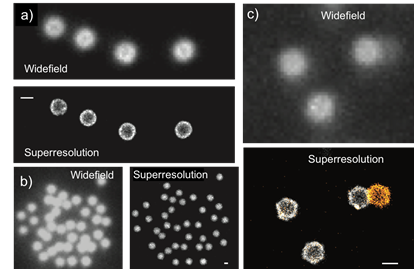Festkolloquium: Nanoscale optical imaging of individual and densely packed microgel colloids
Wann
Dienstag, 16. April 2019
15:15 bis 16:45 Uhr
Wo
R 513
Veranstaltet von
Der Fachbereichssprecher
Vortragende Person/Vortragende Personen:
Prof. Dr. Frank Scheffold University of Fribourg, Switzerland
Microgels are among the most studied colloidal and polymeric systems of the past two decades. Swelling thermosensitive, poly(N- isopropylacrylamide) microgels by lowering the temperature provides a unique mechanism for controlling the porosity and size of colloidal particles on the nanoscale. As a consequence, these smart microgel particles are being considered for applications ranging from viscosity modifiers and sensing to drug delivery and as models for the glass and the jamming transition of soft colloids. Here, we present results from in-situ two-color superresolution microscopy of dye-labelled submicron sized pNiPAM microgels [1]. We first demonstrate direct STochastic Optical Reconstruction Microscopy (dSTORM) to image single microgels in two and three dimensions, at different stages of the volume phase transition, with a lateral optical resolution of 30nm [2]. We find that the swelling behaviour observed in real space matches quantitatively with results from traditional light scattering measurements in reciprocal space. Next, we study dye labelled tracer microgels embedded in dense microgel suspensions. As we increase the packing density we map out the different contributions that allow the dense packing of the soft microgels, due to deformation, interpenetration and compression. Moreover, we can observe shape changes, such as faceting, in dense microgel systems where particles are compressed by the presence of its neighbours [3]. This is all but impossible with other nanoscale imaging techniques used to date (AFM, Cryo-TEM). Based on the detailed understanding of the local structure and morphology we can model the macroscopic elastic properties of dense suspensions over a large range of densities [4]. Interestingly, our results suggest that the friction between the microgels is reduced due to lubrification mediated by the polymer brush-like corona before the onset of interpenetration.
[1] B. Huang, M. Bates, X. Zhuang, Superresolution fluorescence microscopy, Annu. Rev. Biochem. 78, 993 (2009).
[2] G. M. Conley, S. Nöjd, M. Braibanti, P. Schurtenberger and F. Scheffold, Superresolution Microscopy of the Volume Phase Transition of pNIPAM Microgels, Colloids and Surfaces A 499, 18–23 (2016)
[3] G.M. Conley, Philippe Aebischer, S. Nöjd, P. Schurtenberger and F. Scheffold, Jamming and overpacking fuzzy microgel spheres: deformation, interpenetration and compression, Science Advances, 3 (10), 1700969 (2017)
[4] G.M. Conley, Z. Chi, J.L. Harden, and F. Scheffold, Relationship between Rheology and Structure of Interpenetrating, Deforming and Compressing Microgels, submitted (https://arxiv.org/abs/1811.01657)

